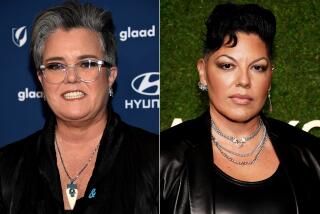Timothy Brock keeps the score in frame for ‘The Cameraman’
Silence has been golden for conductor and composer Timothy Brock.
For nearly 25 years, he has made a name for himself as one of the few composers and conductors who specialize in silent film.
He has composed new scores for and conducted orchestras around the world at screenings of such silent classics as “Nosferatu,” “Sherlock Jr.,” “The General,” “Steamboat Bill Jr.,” “Nanook of the North,” “Sunrise,” “The Cabinet of Dr. Caligari” and “Pandora’s Box.”
On Sunday, at the Los Angeles Chamber Orchestra’s Silent Film Gala at Royce Hall, Brock will be conducting the world premiere of his new score for the 1928 Buster Keaton delight “The Cameraman.”
Also screening is the 1924 Walt Disney short “Alice’s Wild West Show,” with a score by Alexander Rannie.
Brock, whose association with the chamber orchestra goes back some 25 years, was commissioned by the group to write a new score for the Keaton comedy. It was the first the actor made for MGM and features him as a tintype photographer who buys an old movie camera to shoot news events at the urging of a secretary whom he loves.
It takes Brock about six months to write a score. He always watches a film two or three times before he starts fusing music ideas together.
“When I start actually composing, I will write maybe three or four different pieces of music for a piano short score to get the flavor of the film and then I start from frame one to the last frame and I figure out the tempo for that particular sequence.”
Because Brock writes his scores so precisely to the frame of a scene, he has to make sure that the print he uses in composing is the same one that the orchestra will be screening. Often, he has run into problems when the print sent to him hasn’t been fully restored or a shot or scene is missing. “It’s a real gamble sometimes,” says Brock.
In the case of “The Cameraman,” it was film speed he had to keep an eye on. “Some of the restorations that have been out there they did at 22 frames per second,” Brock explains. “I thought that looked a little slow to me. I called [historian and preservationist] Kevin Brownlow and asked him what would be the running speed for ‘The Cameraman’ and he said 24 frames.”
So the composer made sure that the DVD he got from the orchestra to work with was at that speed rather than 22. Every note counts.
Clicking on Green Links will take you to a third-party e-commerce site. These sites are not operated by the Los Angeles Times. The Times Editorial staff is not involved in any way with Green Links or with these third-party sites.
More to Read
The biggest entertainment stories
Get our big stories about Hollywood, film, television, music, arts, culture and more right in your inbox as soon as they publish.
You may occasionally receive promotional content from the Los Angeles Times.







